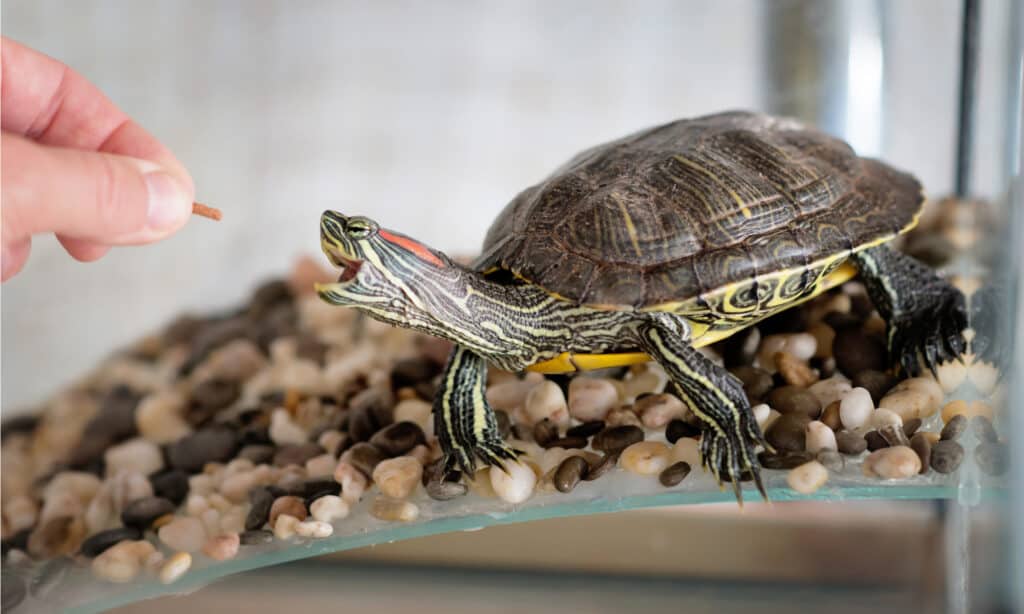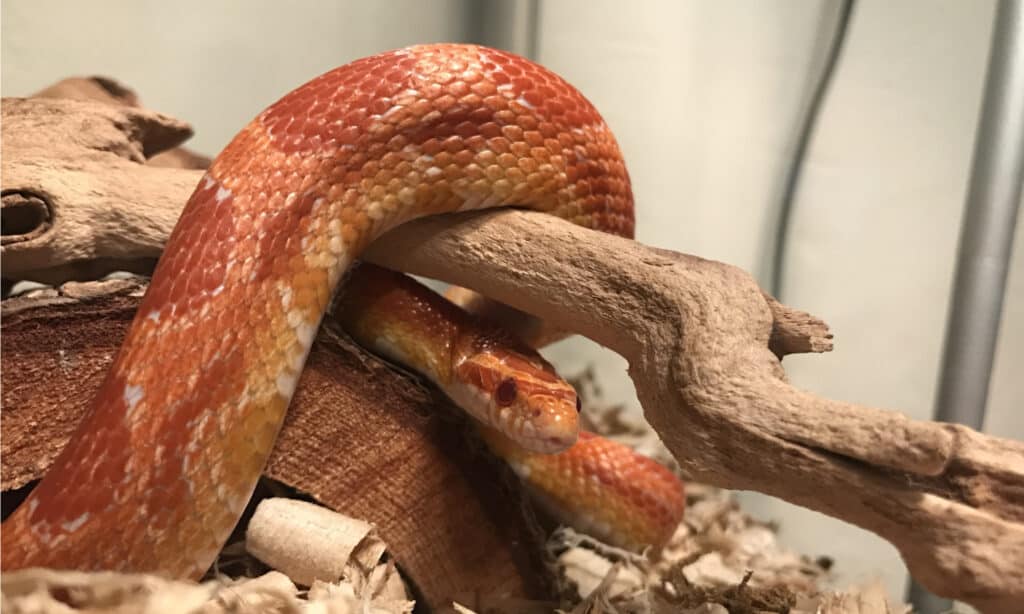Reptiles are vertebrates. In other words, creatures with backbones. These are cold-blooded animals with dry skin covered by either horny plates or scales. Typically, reptiles live in warmer climates.
Reptiles go back over 300 million years. Initially, they resembled small lizards before breaking into unique species. One of those species was the dinosaur which dominated the planet for 140 million years.
The dinosaur may have died out tens of millions of years ago, but there are still a broad variety of reptiles today. Records say you can find over 10,000 species and 2,700 subspecies.
The majority of the species Lacertilia are egg layers. Many reptiles birth live young. In this category are snakes, lizards, and worm lizards.
Generally, the term “reptile” is ambiguous. Genetically, it can refer to snakes, lizards, turtles, alligators, and crocodiles. But it can also include birds as science believes crocs are more related to winged creatures than the reptile family.
The last surviving member of the Anapsid evolutionary tree includes the turtles. Also viewed as reptiles, many in the scientific community recommend turtle classification in the same league as mammals, birds, fish, amphibians as well as reptiles.
All in all, reptiles are extremely popular house pets. Learn more about all the different types of reptiles here.
Why People Love Reptiles in Their Home
Here are several reasons why people can’t get enough of reptiles.
Peace and Quiet
The likes of cats, dogs, and birds can be quite noisy. Reptiles are naturally quiet outside of the occasional hiss. A reptile will never disturb your tranquility.
No Fur
Reptiles shed, but unlike other animals, you don’t have to worry about their gradual drop off, leaving bits of themselves on clothes, furnishings, and other surfaces. In fact, most snakes shed in their enclosures and are best left alone during the process.
Fresh Air
If you keep the reptile’s cage clean, you never have to worry about unpleasant odors. That’s a lot less stressful than dealing with litterboxes, wee-wee pads, and the unfortunate accident on your carpet!
No Destruction
Reptiles don’t chew on furniture legs or cushions. They won’t go through your closet and chew on your slippers. These animals won’t dig at the carpet. They gladly slink about, avoiding trouble, until you put them back in their enclosure.
Low Maintenance
While you need to supply your pet with the essentials (food, water, clean cage, vet care), they will not require the standard maintenance that other pets do (grooming, multiple feeds, bathing, etc,).
Minimized Health Risks
Domestic reptiles pose no threat to health. They rarely trigger allergies. Without shedding fur, there’s also no potential to attract dust mites or other allergens.
Reptiles are fascinating. Whether a common boa constrictor or a bearded dragon, each animal is utterly amazing in many ways. Regardless of any potential domesticity, the creatures elude a sense of being in the wild. They have unique personalities and behaviors. Owners find them relaxing and exciting. And, let’s face it, it’s sure fun to see the reactions of the uninitiated when they find an iguana circling your shoulders!

Before Buying a Reptile
There are far too many reptiles and before buying one, you need to know the characteristics and care needs of any considered pet beforehand. You have to understand temperament and behavior, potential health issues, what they eat, and how to handle them.
Everything is a factor to take into account. Choosing a snake when your home is bested suited for a small lizard is an error you want to avoid. Read this article about the 10 best lizards to keep as pets first to find out which suits you best!
It’s important to understand what each animal brings to the table. The adoption is going to affect your lifestyle. How great an impact that’s going to be will depend on you.
So, before bringing a reptile home, your homework has to include understanding the following:
- Foremost, what are the animal’s needs? Determine if you can realistically manage that reptile’s lifestyle without significantly disrupting your own.
- Budget the cost of owning a specific reptile and establish if you can manage it. This is crucial as the biggest mistake reptile lovers make is overlooking the expense factor.
- If you have other domesticated pets, including a cat or dog, find out if they’re going to get along with your new pet. It’s imagined you may not want to keep the reptile enclosed all the time. You’d hate to expose any living household creature to an undesired encounter.
How Much Does a Reptile Cost to Own
There are too many possibilities to answer the question reliably. So, what we’re going to do is list a few popular reptiles and what you may end up spending on them.
To start, initial costs for reptiles will always vary. For instance:
- Garter snakes: $15–$25
- Corn snakes: $40–$120
- California kingsnakes: $60–$300
- Hognose snakes: $100–$700
Expenses will vary from region to region, across subspecies, sellers, and more.
Snakes
- Equipment and Requirements: Cage, thermostats, bedding, etc.): $100–$125
- Feeding: $50 to $200
- Veterinary care: $100–$125*
Potential Total: $250 to $450 annually
Lizards
Depending on the species, the price range for a lizard can start at $15 and work its way into the thousands.
- Equipment and Requirements: such as cage, liability insurance (as required by state), substrate, etc.; varies
- Feeding: $120 to $200
- Veterinary care: $40–$80*
- Vitamins: $5–$10
Potential Total: $165 to $290 annually
Iguanas
Iguanas make for great pets. Liabilities for owning the animal can include insurance. The Green Iguana, a common pet, is going to cost between $15 and $35. A unique breed like a Cyclura is in a higher range, such as $250–$600.
- Equipment and Requirements: $100–$125 (cage, supplies, etc.)
- Feeding: $50–$100
- Veterinary Care: $100–$125*
Potential Total: $250–$350 annually
* Doesn’t include unexpected medical treatments or medications.
New Owner Shopping List: What To Buy
Reptiles are going to need unique ecosystems that ideally, you’d have set up and ready before bringing home your new friend. Sound vivariums, sanitation, lighting, humidity, maintenance, and more are the only way to guarantee the health, safety, and enjoyment of the animal.
Here are some general things that you want to put on the shopping list.
Enclosures
Every reptile needs caging. Enclosures can be glass, plastic, or fenced. There are only two critical components in all purchases: (a) cages must be escape-proof and (b) they must, must, must be the right size.
Many newbies buy enclosures based on current size without factoring in growth. The wrong tank can create severe stress, illness, and behavior issues. Reptiles may injure themselves trying to break out. If you’re lucky, the seller schools you before you make the mistake.
Buy a cage that’s two or three times the reptile’s largest potential growth. If you do not have that kind of room, get a smaller, different reptile. If you can afford to rebuy and rebuild an ecosystem later, good for you. But it’s better to develop and build on an environment your pet’s already found comfort in.
You may have to think outside the box. Enclosures for creatures like boas and large blood pythons are not sold commercially. You may need to build one or have one built.
Climate
Reptiles are cold-blooded. The animal needs appropriate temps to maintain its body heat and the enclosure has to manage this. Modulated temperatures have to accommodate the animal’s movement and its needs to warm up or cool down. You may need basking lights, radiant heaters, undertank heaters, etc.
Lighting
Lighting helps with heating and reproducing a reptile’s natural habitat. That’s critical if you’re keeping a pet used to desert or tropical ecosystems. As the months heat up or grow cold, you have to ensure enclosure temps stay consistent. You also may have to accommodate the animal’s leaning toward nocturnal or diurnal behavior.
You may be able to use a single light source for heating and light. However, a species may need higher ambient temps than your room creates. In that case, you’ll need separate heating and lighting solutions.
Food
With over 10,000 different types of reptiles, we’re talking as many thousands of diets. Again, let’s stick with popular species, but always research the reptile you’re interested in thoroughly.
Snakes
Snakes are obligate carnivores and cannot live on vegetables or fruits. Depending on the species, they can eat anything from crickets and other insects to rats, rabbits, or even pigs.
In captivity, many pet snakes feed on rodents. They’re the easiest meal for homeowners. Not many realize they need to take care when giving their snake live prey. A live rat certainly can hold its own in some snake fights. If the snake doesn’t eat the prey inside of 15 minutes, take the food out and save it.
It’s also important that you’re comfortable feeding live prey. The last thing you want is to fumble and end up having the rodent run loose. If that’s the case, go with a snake that prefers vegetables and plants.
RELATED: Are Snakes Reptiles?
Lizards
Smaller lizards tend to be insectivores. But you have your omnivores and herbivores. The general snake owner feeds their pets mealworms, crickets, waxworms, or the like. You may need to explore supplements with insectivores that only feed on crickets to manage nutrients.
Testudinidae
The Testudinidae batsch and Testudinidae fitzinger consists of the tortoise and softshell turtle families, respectively. Testudines batsch makes up the hard-shelled variety.
As these are extremely slow-moving creatures, they’re not good with food that runs away. So, Mother Nature gave these animals less taste for meat. They prefer leafy greens, fruits, and flowers. Aquatic turtles will chow on insects or fish. Those specific reptiles may need a vitamin pellet or supplement to augment meals.
RELATED: Are Turtles Reptiles or Amphibians?
Ongoing Care
A lot of people go for reptiles believing they require minimal care. That’s not always the case.
Snakes
Snakes can live for decades and grow to varying lengths. Care, size, diet, environments, and more impact care. Tanks have to give snakes no wiggle room for escape. Environments need grooming and tending to make for a conducive ecosystem.
Strictly controlled temps based on time of day may be necessary. You may need to stomach live feeding. Checkups with specialized vets may be part of the programs. Some snakes are prone to parasites, digestive and respiratory disorders, mouth rot, and blister disease. You may need to prevent mite infestation with pesticide application.
Iguanas
Owners who find themselves taking on more than they can chew often abandon the pet. The common green iguana is a frequently discarded pet.
A healthy iguana can live 20 years and grow over six feet. Their environments have to be exacting. They can suffer from metabolic bone disease, ulcers, abscesses, and more. (And only animals in captivity suffer these illnesses!)
Management of iguanas can cost hundreds of dollars a year. Sexually mature males can be hard to handle. Heck, a trigger for aggression can be their reflection! An iguana needs a family ready to work to keep it comfortable and happy.
Turtles
Most North American turtles are taken from their natural habitats. Other species are captive bred, typically among the 60 Louisiana farms that exported over 11 million turtles in 2020.
Many states restrict or ban turtle sales. The guidelines lead to a lot of illegal captures. It also influences less-than-healthy creatures. Many turtles in the market are victims of stress, fungi, bacteria, or parasites.
In captivity, they need water to swim in and dry areas to walk. Tanks require thermostatically controlled environments and large housing. Aquatic turtles have up to 25 years to live. A land tortoise could outlive all of us.
Geckos
If you can’t handle a six-foot reptile, a gecko might be the way to go. Small and frail-looking, they’re found in temperate and tropical regions and require specific ecosystems with no compromises. Geckos eat baby mice and insects. They need a water bowl, branches for climbing, hiding places, and an enclosure that restricts their Houdini skill.
Feeding Your Reptile
It shouldn’t just be a matter of what the reptile eats. Owners need to be comfortable with what they feed. Anyone squeamish about giving a python a live rabbit shouldn’t have a meat-eater.
Here are the types of food categories you’ll find among captive reptiles.
- Carnivores eat meat. Snakes and certain lizards chow on rats, mice, bird eggs, fish, and insects, all eaten raw and usually alive.
- Herbivores like their plants. Some tortoises and iguanas are pure vegetarians. They eat romaine lettuce, chopped collard greens, and fruits like bananas and apples.
- Omnivores are happy with meat and plants. They eat chopped veggies and earthworms.
- Insectivores prefer insects. A common rule of thumb is the smaller the animal, the smaller the prey. Good examples are anoles and chameleons.
- Folivores eat leaves. In the wild, they gnaw on anything found in the trees.
- Piscivores eat fish.
How Long Will Your Reptile Live?
There are way too many variables here for even an average lifespan. But you can easily find out by typing “lifespan of (reptile name)” into your search engine.
Common Health Issues for Reptiles
Again, the possibilities spread across 10,000 species make a simple answer impossible. Use your search engine or, better yet, have a confab with a vet or breeder.
Where to Buy Your Reptile
You can buy reptiles online, at brick-and-mortars, and through breeders.
It’s a risky bet to have a pet shipped. It may be necessary if you’re looking at a rare breed that can’t be found locally, but the risk is still there. With most online purchases, you can’t vet where the pet came from so reliability’s out the window and you have to go one faith.
Online or shipping, you’re better off going directly to a breeder. You’re not only more likely to get a knowledgeable source and a better price, but you can also get practical counsel on how to take care of your pet.
A brick-and-mortar gives you a greater opportunity to interact with the animal at your own pace. You’ll also have the chance to view them in their environments and get a firmer grasp of what’s required to take care of it firsthand.
For the Beginner: Best Choices for Reptiles for the Kids
No creature is more fascinated with reptiles than children. Making a gift of a reptile to them teaches responsibility, patience, compassion, trust, respect, and how to manage a schedule. But we don’t want to put them in over their heads.
In that regard, here are three excellent choices for the kids.
Ball Python
The ball python can be anti-social and picky with food but require basic care. A 40-gallon tank, a hidden heat pad to promote belly heat, and a bowl fueled with fresh water. You need to monitor humidity levels (an ideal level is 55 percent). The more areas where the python can hide the happier it is. The creatures can be quirky eaters, but they will fall in line over time.
Leopard Gecko
With what looks like a big smile and bright eyes, the leopard gecko is an adorable lizard. They need an easy setup. They’re easy to feed and only need a heat mat. The creature can stay in a 20-gallon tank for its entire life. The tank should have a cool side and a warm one. The gecko needs three hides: a cool side, in the middle, warm side. Geckos do not need a heat lamp. See this interesting article about setting up your Leopard Gecko tank!
Corn Snake

The corn snake, or red rat snake, is extremely variable and flexible. They come in a litany of beautiful patterns and colors. They have soothing dispositions and seem pretty comfortable with handling. They can reach a length of 66 inches and don’t need a tall tank. They like to roam so decorate the enclosure with artificial foliage, a secure humid hide, branches and logs, and, of course, a dish of consistently refreshed water.
RELATED: 7 Best Reptiles to Keep as Pets
Special Considerations for Reptiles
Though we see constrictors hanging on necks or a Chinese water dragon seemingly happy to sit on someone’s leg, the truth is most reptiles don’t like handling.
They’ll learn to appreciate your company, but in general, the likes of solitary snakes or turtles would rather have a little free time outside the enclosure with a return to the comforts of home.
You want to recreate as close as possible the habitat they’re used to. Adhere to specialized diets and don’t presume you can choose their diet. Keep live prey, fresh vegetables, and vitamins and mineral supplements unique to the species as needed.
It’s important to practice good hygiene when you do have direct contact with a reptile. Wash hands with disinfecting soap after handling the animal or its eco-contents. Use disposable gloves, disinfect and slightly water spray the enclosure as needed. Always use eco-friendly cleaners and tools. PLEASE never kiss your reptile. And always supervise children around the creature.
Keeping Pet Reptiles – Types, Care, Feeding, Cost, and More FAQs (Frequently Asked Questions)
What is UVB and Does My Reptile Need It?
UVB is a spectrum of light in the ultraviolet spectrum. It’s essential to all life, but especially to reptiles active during the day. It helps the body synthesize the D3 vitamin that metabolizes calcium.
Do Reptiles Grow to the Size of Their Tank?
Only if you buy one, the animal can grow comfortably. Small cages make animals aggressive, sick, and unhappy. Don’t get an appropriately sized enclosure, get one the animal will be comfortable for the remainder of its lifespan.
Do Reptiles Carry Salmonella?
Many do have Salmonella. But you’re more likely to get the condition from around the house. There are at least 50,000 cases of Salmonella every year. The ones linked to reptiles consist of less than 0.1 percent of that number.
Thank you for reading! Have some feedback for us? Contact the AZ Animals editorial team.




